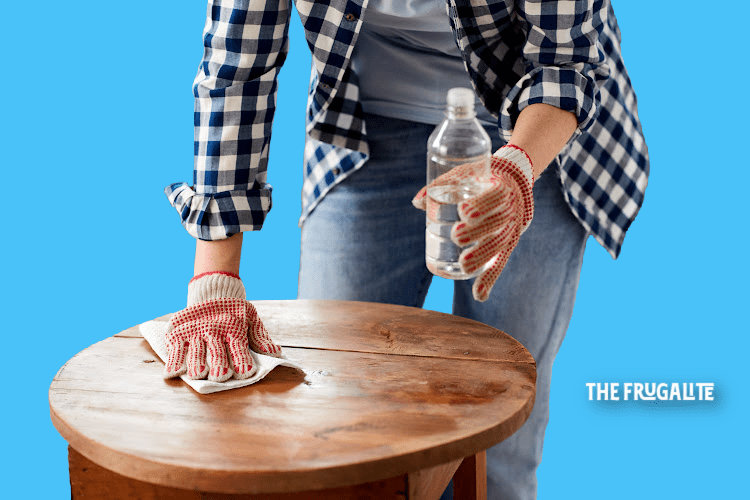(Psst: The FTC wants me to remind you that this website contains affiliate links. That means if you make a purchase from a link you click on, I might receive a small commission. This does not increase the price you’ll pay for that item nor does it decrease the awesomeness of the item. ~ Daisy)
By the author of What School Should Have Taught You: 75 Skills You’ll Actually Use in Life
So if you’re attempting to refinish some old furniture (or make your own, or pretty up some second-hand pieces) and you’re trying to do so on the cheap, I have a few thoughts on some of the different stains and finishes that are out there. This may help you to make a more wallet-friendly and informed decision when refinishing furniture.
Stain pens are a waste of money.
If you go to the store and see a $10 stain pen that can be used for touch-ups, I say don’t waste your money. You can do the exact same thing with an old T-shirt and an actual can of stain. Odds are that the can of stain will be right around the same price (if not less) and you’ll get WAY more stain out of it than you ever would out of that stupid little pen.
In addition, if you lose the tip of the stain pen (it happens), then you’re just out of luck. No tip, no functioning pen. Get yourself your can of stain, get yourself your T-shirt, and then very gingerly touch up the area that you need to touch up and then wipe up the excess as quickly as possible. You’ll accomplish the same goal and it’ll be a lot cheaper to do.
Old T-shirts are where it’s at.
You’ll see hardware stores selling stain cloths that you can buy for whatever project you have coming up. These work, but they’re an expensive option. I will say that the rags you buy at Harbor Freight will leave little red fuzzy cotton balls all over your furniture, embed in the drying stain, and ruin everything.
Find an old T-shirt, cut it up into little rag-sized pieces, and use it instead. If you don’t have any old T-shirts, pick some up for a few bucks at your local Goodwill. You’ll save yourself a lot of money, end up with functional rags, and the furniture will look just fine.
I do not like wipe-on polyurethane.
You can buy this in a big container, with the selling point being that you just wipe this on a piece of furniture without needing to brush anything, and voila, your furniture has been polyurethaned. What I’ve found, though is that this ends up taking an exorbitant amount of time.
I made a farm table using this stuff, and I think I had to put on seven coats before I could even begin to tell that I had poly on it. The stuff is so thinned down that it takes a kajillion coats to actually do anything. Keep in mind that you not only have the time it takes to apply this stuff to your wood to consider but the time it takes for this stuff to dry.
You can spend two hours brushing on polyurethane this Saturday, or you can spend the entire Saturday using wipe-on poly. I would much rather choose the brush-on type and be done with it.
Butcher block conditioner disappears fast.
I’ve used this stuff quite a bit in the past. Just keep in mind that if you think you’re going to get away with using this for your furniture and nothing more, you’re going to have to reapply it on a regular basis as it wears off. I prefer one-and-done options, like shellac, but if you go this route, just keep in mind that you now have a new maintenance project you’ve created for yourself.
I do not like flat coatings.
I’ve never found that flat polycrylic or other flat coatings makes my furniture look the way that I want it to. I suppose if you want it to look like you took a board and stained it and that’s it, then you could get away with flat polycrylic. Personally, I don’t like things looking flat like that. I want my furniture to have a bit of a sheen to it, and for that reason, I’m a huge fan of shellac and polyurethane.
If you’re of the same mind, this can save you from wasting $15 on a can of this stuff. Even if you’re into the whole farmhouse look, I still don’t think you’ll really like flat. Shellac is truly where it’s at.
Only use wood filler for paint jobs.
Do not ever buy a piece of used furniture with some type of divot thinking that you can just patch it with wood filler and then stain everything to look just like new. You can’t. It’s impossible.
Wood filler has its place, but staining is not it. You will never be able to get that filler to stain to the same color as the rest of the wood. Instead, you’ll end up with beautiful, dark brown wood over here, and then what looks like a glazed piece of khaki Play-Doh over there. It looks ridiculous.
However, if you’re intending to paint your furniture, then you can effectively use wood filler in the gouge, sand it down, and paint the thing without people paying it any heed. Knowing this ahead of time can save you a bit of time, money, and frustration.
You can save a bit of money fixing your own furniture.
Fixing up your own furniture is a lot of fun, particularly when you realize how much money you’ve saved yourself compared to going out and buying something that’s brand new. But there are some mistakes that can be made along the way that will cost you time and money if you’re new to it. Hopefully the above will help you to avoid some of those mistakes that I myself have made (some a number of times).
What are your thoughts on all this, though? Do you have more to add that you think would be of benefit to our readers? Are you too on the correct side in thinking that shellac is where it’s at, or are you sadly misinformed, mistaken, and someone who is probably wearing their pants backward at the moment?
Let us know your thoughts in the comment section.
About Aden
Aden Tate is a regular contributor to TheOrganicPrepper.com and TheFrugalite.com. Aden runs a micro-farm where he raises dairy goats, a pig, honeybees, meat chickens, laying chickens, tomatoes, mushrooms, and greens. Aden has four published books, What School Should Have Taught You, The Faithful Prepper, An Arm and a Leg, The Prepper’s Guide to Post-Disaster Communications, and Zombie Choices. You can find his podcast The Last American on Preppers’ Broadcasting Network.












1 thought on “Refinishing Furniture on the Cheap”
The clue with wood fillers is to mix them to match the color of the stained and finished piece. Hunks of waxy stick fillers can be blended with warm hands usually in a warm environment or softened in a small container in hot water. They can then be applied with fingers or a stiff piece of plastic. Metal would scratch the finish.